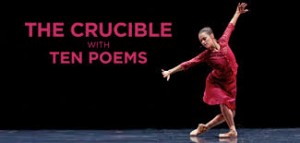Here are two of our Young Critics first reviews, both of The Crucible with Ten Poems.

For more information, and details of touring dates in Edinburgh and Aberdeen please visit the Scottish Ballet’s website.
The Crucible with Ten Poems
Scottish Ballet
Elaine Docherty, GWL Young Critic
Ballet without music? Yes. When you use Richard Burton’s velvety voice reading Dylan Thomas’ Ten Poems, this unlikely combination works. Teamed with the Scottish Ballet it made for a rhythmic and fulfilling production.
Christopher Bruce’s choreography brings a selection of Thomas’ best known verses to life within this emotional performance. Andrew Peasegard played various roles across different poems with a nostalgic feel.
On the other side of the spectrum: The Crucible. Chaotic, busy, paranoid, Helen Picketts’ take on Arthur Miller’s 1953 play packs two hours worth of emotional intensity into 45 minutes.
The passionate affair between Proctor and Abigail sparks the destruction of the Salem Witch Trials. Cleverly thought out costumes help us to recognise when the young girls are naked in the ‘dance in the forest’ which is the hare that starts the greyhounds running.
Spotlit solos, Abigail and Proctor’s sultry duet, a score that changes from film noir to bold techno: there was a lot to appreciate. However there was not enough time to enjoy it properly.
The Crucible with Ten Poems
Scottish Ballet
Issra Siddique, GWL Young Critic
The girls come on from different sides of the stage. They start with slow elegant movements, slip off their shimmery brown net over-dresses to show white underclothes. As they get in to the character the dance get faster and furious and the music matches their movements. It feels intense.
Scottish Ballet’s adaptation of Arthur Miller’s play – the Crucible – tells the story of women being accused of witch craft.
The way the dancers move their bodies and their extreme flexibility made me sit up forward in my seat, and the arrangements of the many dancers moving across the stage was satisfying to watch. But I was left confused about the story.
I am from Pakistan and western classical dance is a different world. Some of the images did not mean anything to me. Afterwards I found out the court scene could also be a church but at the time that didn’t seem clear. And I didn’t recognise the symbolism used to accuse the women of being witches. For me it was really difficult to follow.
Still, it grabbed me and made me think hard what it was all about. I will go to the ballet again. This time I might understand more.

Comments are closed.